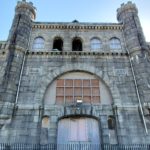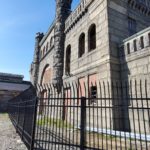
November 23, 2021 UMass Boston Readies Calf Pasture Pumping Station for Redevelopment
Near Dorchester Bay, on the campus of UMass Boston, the 1883 Calf Pasture Pumping Station sits unused and neglected. However, the prospects for the historic building – one of the country’s first organized sewage management systems – is looking up. UMass Building Authority is preparing a Request for Proposals to attract a developer for this building and 10 surrounding acres of land.
Immigration and increased population density in 19th century Boston created unhealthy living situations, particularly for the poor, where open sewers contaminated water and caused thousands to die of typhus and cholera. To arrest the problems associated with sewage management, a City commission was formed in 1875 to plan a system that would collect raw sewage in pipes throughout the region’s cities and towns and send it to a central outflow facility at Columbia Point. Two large pumps, designed by engineer Erasmus Leavitt, within a new pumping station would send the effluent to tanks on Moon Island in Boston Harbor, where it was stored before the tide washed it out to sea. This was known as the Boston Improved Sewer System (“B.I.S.” shows on the building’s façade, facing the Harbor). The structure, designed by City Architect George Albert Clough, opened in 1883.


The Leavitt pumps in the station raised sewage pipes 35 feet into the air so it could flow downhill to Moon Island. The pumping station’s steam pumps were replaced by electric ones in 1940, and the station went out of full service in 1968, when a new sewage treatment plant was built on Deer Island, but it remained on standby for use during heavy rains.
The UMass Building Authority is looking for ideas for how this handsome property can be saved and redeveloped to the university’s and the community’s benefit. An initiative to save the medieval-looking structure petered out about a decade ago, but the new request for proposals to save the building is expected soon, and includes 10 acres of open land on two parcels adjacent to the Calf Pasture Pumping Station that can support enough new development to make preservation of the historic building more feasible.
Historic Boston is working with New Atlantic Development and Utile architecture to explore redevelopment options for the historic structure in anticipation of the forthcoming RFP.
A recent tour through the pumping station put on a haunting display of industrial debris of its former use: giant rusting pipes and pumps that once sent sewage away from the growing City before sewage treatment was in use; cavities in the roof open to shards of sunlight; rickety wooden floors and concrete slabs. Disused industrial equipment sits tipped over on the floors or hanging precariously from high beams. Hard hats were required for entry.
Aside from the two land parcels, one now a parking lot, the pumping station includes two outbuildings on the Columbia Point peninsula. These include a gatehouse for managing water inflow and outflow to Moon Island, and another that was the entrance to the effluent shaft.
“We believe that the historic building is the most complicated – and yet the most rewarding – segment of the 10-acre property that the UMBA is seeking interest in,” Historic Boston and its partners wrote in a letter of interest to the UMass Buildings Authority. Newmark’s Boston Capital Markets Group is managing disposition of the property and building, which is on the National Register of Historic Places.



